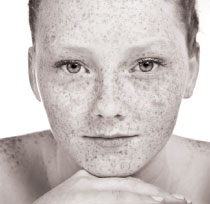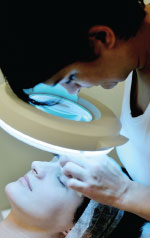Since skin is a living organ, our body's largest organ in fact, it is a reactive mechanism; in other words, it responds to internal and external factors. Everything we put into and on our bodies, along with our environment, stress levels, and sleeping patterns have an impact on the skin. As aesthetic professionals, our primary goal is to create healthy, youthful skin for our clients. To achieve this goal we must educate clients about the impact of a healthy lifestyle in addition to providing the proper corrective treatments specific for their skin.
Intrinsic Agers
While much insight has been made into what causes our cells to stop or slow the regeneration process, we have yet to discover how to reverse this process. Adding to the challenge is our unique genetic programming, which dictates when our cells begin the degradation.
Skin cells are amazing structures, but they are also very sensitive. Cells do have the ability to repair themselves, but as we age this process slows and there are a number of elements that threaten their integrity. The damage occurs when oxidative stressors like the sun, pollution, chronic stress, smoking and free radicals penetrate skin cells where they break down collagen and impact the DNA structure of the cell. As damage occurs, over time the cell is more likely to replicate it and the damaged cells multiply.
DNA aging also impacts the production of collagen, which by definition is the main component of connective tissue and most abundant protein in mammals. It forms in elongated fibrils (fine fibers) in our tendons, cartilage, bones, blood vessels and skin, among other areas.
In our world we know collagen is responsible for limiting the appearance of fine lines, wrinkles, and saggy, slack, and crepe-like skin. Unfortunately, production of this youth-preserving protein decreases as we age. Signs of aging occur when the fibroblast cells that step in to repair damaged collagen fibers cannot complete their work – a product of aging cells.
Though we cannot stop or reverse our clients' internal clocks, we can help them slow intrinsic aging by educating them on the impact of a healthy lifestyle.
Extrinsic Agers
Luckily we know a great deal about the extrinsic agers and by addressing those, we may be able to prolong the timer on our genetic decline. First, let us examine some of these extrinsic factors and how to halt their damaging effects.
As I mentioned, the most common culprits include sun exposure, smoking, pollution, chronic stress, poor sleeping, diet and exercise habits – all of which are known producers of free radicals, but more recently free radicals have also been linked to poor sleeping and eating habits, exercise and overall lifestyle.
Smoking and Toxins
One puff of cigarette smoke emits 40,000 free radicals, and recent studies have revealed there are actually two types present in cigarette smoke, both conspiring to deplete the body of vitamin C and accelerate aging.
 Free radicals are also prevalent in the atmosphere in the form of pollution, which occurs when molecules undergo a photo-dissociation process. This reaction plays a key role in smog formation and naturally also wreaks havoc on the skin. A good defense against these elements is a natural blocker like zinc, and the other obvious one is to not smoke.
Free radicals are also prevalent in the atmosphere in the form of pollution, which occurs when molecules undergo a photo-dissociation process. This reaction plays a key role in smog formation and naturally also wreaks havoc on the skin. A good defense against these elements is a natural blocker like zinc, and the other obvious one is to not smoke.
Stress and Sleep
According to the "Stress in America" survey by the American Psychological Association, 44 percent of Americans say their stress levels have increased over the past five years. What does this do to the skin?
Constant worry and stress impact the regulation of hormones and chemicals, and reduces immunity, allowing more viruses in the body. This ultimately leads to cell damage, resulting in dull skin, slack pores, age and stress lines, and other tissue damage. A recent study by researchers at Duke University Medical Center also found that chronic stress ultimately led to DNA damage that ranged from aging of skin and hair to proliferation of diseases and malignancies.

A major inhibitor of stress is adequate sleep. Proper sleeping habits also help our cells regenerate, thus supporting a youthful appearance. With sleep however, it is not just quantity, but quality. The television and cell phone should be off; the room should be dark and cool to achieve a deep sleep.
Diet and Exercise
Exercise is absolutely essential to our health, as well as regulating circulation and the flow of oxygen to skin cells. However, too much exercise can actually proliferate free radical damage. Studies have shown excessive exercise to cause oxidative stress created by free radicals. During strenuous exercise we produce significantly higher levels of reactive oxygen species (ROS), exceeding our body's natural antioxidant defenses. Our bodies begin to pull antioxidants from tissue stores, depleting the body's reserve of antioxidants. Over time damage occurs to our cells and tissues.
A healthful diet rich in antioxidants, supported by antioxidant-rich topicals, will help replenish the loss. Advise clients to look for these antioxidants, both in food and skin care formulas:
- Vitamin A – carrots, kale, spinach, pumpkin, liverand cantaloupe.
- Vitamin C – camu camu, broccoli, Brussels sprouts, guava and citrus.
- Vitamin E – olive oil, walnut oil, wheat germ oil, oats, tomatoes and carrots.
- Bioflavonoids – citrus, berries, onions, tea, red wine, dark chocolate and sea buckthorn.
- Polyphenols – berries, tea, dark chocolate, walnuts, peanuts and pomegranates.
Antioxidant topicals will help firm, tone, tighten, refine lines, and give skin an overall glow. Look for ingredients like ascorbic acid, tocopherols, superoxide dismutase, goji berry, retinoids and L-Lactic acid ... to name a few.

Sun Exposure
 I cannot stress this enough – excess UV exposure is responsible for 90 percent of photo-aging – wrinkles, brown spots, slack skin, et cetera. Most clients are aware of this, but the lure of bronzed skin is sometimes far too appealing. As skin care professionals, it is important we stress the implications of exposure to the sun and using proper protection.
I cannot stress this enough – excess UV exposure is responsible for 90 percent of photo-aging – wrinkles, brown spots, slack skin, et cetera. Most clients are aware of this, but the lure of bronzed skin is sometimes far too appealing. As skin care professionals, it is important we stress the implications of exposure to the sun and using proper protection.
UVA rays reach deep into the dermis, damaging collagen fibers by forming abnormal amounts of elastin and increasing metalloproteinase production. Collagen begins to malfunction and decompose; incorrectly rebuilding the skin and forming wrinkles along the way. This process repeats every time the skin is exposed to UVA rays.
Halting the Aging Process
With all of these aging factors continually assaulting our skin, what defense do we have? Educating clients about extrinsic agers and how to prevent their damaging effects is one part of the equation. We also have a bevy of fixes at our disposal to correct everything from fine lines to deep wrinkles and discoloration to slack skin. These tools include intelligent ingredients and advanced treatment room technologies.
Using nature and advances in science, we can inhibit the cell's aging process, reduce age spots and hyperpigmentation, and enhance cell regeneration. A few intelligent skin care ingredients include organic stem cells (which promote longevity in human cells) new-generation peptides, thermus thermophilus ferment, retinol, epidermal growth factor (EGF), resveratrol and other antioxidants. Antioxidants work to disable free radicals and prevent cell damage by inhibiting the oxidation of other molecules. An interesting fact, however, is that antioxidants are actually oxidized themselves, which is what enables them to effectively terminate oxidation chain reactions.
Corrective Peels
Peels, when properly administered, are one of the most powerful non-surgical skin improvements available. They remove cellular buildup, stimulate skin regeneration, and reduce wrinkles, fine lines, large pores and oiliness. They also aid in clearing blemishes, treating hyperpigmentation, and improving overall texture and tone.
At the core of a peel treatment, highly specialized acid and enzyme solutions are applied to remove damaged layers of cells from the skin's outer surface – revealing more glowing, youthful skin. Treatments vary in intensity, and a client's skin type and desired results will dictate which peel treatment is best. Proper training in administering any peel treatment is always recommended.
Microdermabrasion
Micordermabrasion is a non-invasive procedure that works by removing the outermost layer of dead skin cells. Since it does not typically involve downtime, it is one of the most popular and frequently used modalities for skin rejuvenation. To deepen its effects, use ingredients like kojic acid and L-mandelic acid to lighten and gently retexture and regenerate the skin. L-lactic and salicylic acid, papain enzyme, and bromelain enzyme will also intensify the treatment by exfoliating keratin and supporting tissue regeneration.
Laser
There are many different types of laser machines available, but laser facials generally fall under two classifications – ablative and non-ablative. Ablative lasers are more intense, requiring downtime, and work by vaporizing damaged skin with intense wavelengths of light that reach the skin's epidermis. Non-ablative lasers are less intense and do not reach as far as ablative, therefore the injury to the skin is very minimal. It targets imperfections, bringing them to the surface to reduce their appearance or correct them. Laser treatments can be enhanced with pre-treatment enzymes or light peels to further lighten and resurface the skin. It also helps speed the recovery.
LED and Microcurrent
 LED (light emitting diode) light therapy works to stimulate and energize cellular activity. LED treatments can often be paired with certain corrective and acid formulas to enhance cell turnover as the light intensifies the activity.
LED (light emitting diode) light therapy works to stimulate and energize cellular activity. LED treatments can often be paired with certain corrective and acid formulas to enhance cell turnover as the light intensifies the activity.
Microcurrent uses mild electrical currents to cause muscles to contract and relax, which strengthens them and enhances blood flow to the skin. Pairing this procedure with peptides will boost the firming and lifting of the skin.
Injectable Fillers
Like laser procedures, there are also a number of injectable fillers on the market today, and it is a big business. According to the American Society of Plastic Surgeons there were approximately seven million injectable filler treatments performed in 2010 alone. Fillers have come a long way. Today there are some formulas that work to stimulate the body's own collagen production mechanism and others that last up to three years.
Following the procedure, any number of reactions may occur at the injection site – redness, bruising, inflammation, tenderness – using ingredients such as linoleic and oleic acid, vitamin E, bisabolol, arnica and hydrocortisone will actively accelerate healing time for your clients. To support the re-youth effect of the filler, you might also provide clients with hyaluronic acid and peptides. These will further stimulate collagen and keep skin hydrated and plump.
While we still have not discovered the "Fountain of Youth," there is much we can do as aesthetic professionals to turn back the clock on the visuals signs of aging and encourage our clients to embrace life and welcome the wisdom that comes with years. Be sure you are providing clients full spectrum support by educating them on making healthful lifestyle choices in combination with their skin treatments and daily regimens as well.
Rhonda Allison, a pioneer in the skin care industry, is the founder and CEO of Rhonda Allison Cosmeceuticals and RAW Skin Care for Men. She is also an author and internationally known speaker with more than 30 years' aesthetic experience. www.rhondaallison.com and www.rawmethod.com
Want to read more?
Subscribe to one of our monthly plans to continue reading this article.